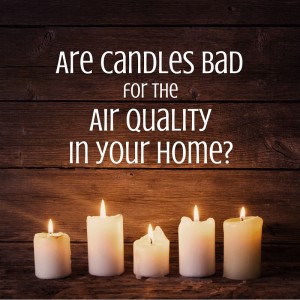After a stressful day at work, during a relaxing bubble bath, or to cover up the smell of a burnt dinner disaster—candles are great for providing ambience and a fresh aroma. But are they affecting the air quality in our homes?
Yes—but keep reading. When candles are burned, they release carcinogenic toxins (benzene, toluene, formaldehyde, acetaldehyde, acrolein and) most recognizable, soot into the air. The emissions from paraffin candles contain many of the same toxins produced by burning diesel fuel.
Paraffin (petroleum-based) candles and scented/aromatic candles are the worst offenders—and also happen to be the most common candles on the market. Pollution from candles can contaminate ventilation system’s ductwork in homes; not to mention candle pollution can also discolor walls, ceilings, and the contents of a home.
On the personal health side of things, lighting many candles frequently in an unventilated space can lead to problems such as aggravating asthma, causing allergy-like symptoms, or irritating the respiratory tract.
Should this information scare you away from ever lighting candles again? No. When limited and used correctly, candles are not a scary thing in terms of effecting air quality.
How to get the benefits from candles while minimizing the consequences:
- Proper Wick Size. Trim the wick to ¼ inch before lighting for the first time. Avoid wicks that are too thick and those with a wire core that keeps it upright. Candle wicks should have thin, braided wicks that curl over when burned. They should also burn down evenly with the wax.
- Avoid Containers. Containers with narrow mouth openings will cause unsteady air flow and increase flicker. Use free standing candles placed on a plate to avoid wax drippings on your furniture.
- Ventilation. Only burn candles in rooms with great ventilation, but avoid direct drafts on the candles.
- One Hour Maximum. Extinguish candles after one hour of continuous burning and allow them to cool before relighting.
Alternatives:
- Candle Warmer. Candle warmers require no flame and gently warm the wax of a candle. Warming a candle does not emit any smoke, soot, or chemicals.
- Diffuser. If you like to burn candles solely for the aromatherapy and to add fragrance to a room, you can swap out the candle for a diffuser. Diffusers disperse essential oils that fills a room or area with natural fragrance.
- Beeswax or soy candles. If you must use an actual candle, try beeswax or soy candles. These candles burn cleaner than regular paraffin wax. Beeswax candles clean the air by releasing negative ions into the air which bind with toxins and help remove them from the air.
How to Improve Poor Air Quality
If you suspect that the air quality in your home may be poor, don’t be discouraged. There are solutions to this problem. Humidifiers are one of the first methods of defense to improve air quality. These devices put moisture in the air, making it easier to breathe and to reduce the issue of dry skin. Another important benefit is protecting the wood in the home. When the air gets too dry, it can cause the wood to shrink and creak while drywall and plaster can crack. Besides protecting your health and that of your home, a side benefit of humidifiers is they make a home feel warmer in the winter.
Air purifiers remove toxins from the air to ensure that what you breathe in is healthy and safe. There are different types of purifiers, which work in unique ways. For example, a central air cleaner is attached to the heating and cooling system, which gets ride of pollutants from the air before they come into the house. Ultraviolet air purifiers use a light to neutralize bacteria and other pollutants. Air exchangers replace unfiltered air with that which has already been filtered while ionic air purifiers change the electrical charge of the molecules to create cleaner air.
HEPA filters also improve the air by preventing particles such as pollen, dust mites, pet dander and even cigarette smoke from getting into the air through the furnace or air conditioning system. Not just any filter can quality as a HEPA filter. For one to get this title, it must remove 99.97 percent of all particles.
If you think the indoor air quality your home has experienced any effects from burning candles, call Blue Ox. Our team of expert technicians can provide you with air quality services and solutions. Humidifiers, Air Purifiers, and HEPA Filters are just a few of our products that can improve your air quality. Don’t delay bringing the air quality in your home up to higher, healthier standards— schedule an appointment today.



Comments are closed.